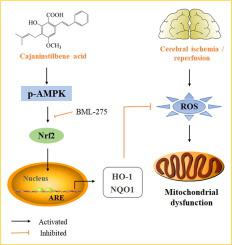Journal of Advanced Research ( IF 11.4 ) Pub Date : 2020-07-23 , DOI: 10.1016/j.jare.2020.07.011 Hui Xu 1, 2 , Jiangang Shen 3 , Jianbo Xiao 4 , Feng Chen 1 , Mingfu Wang 1, 2

|
Introduction
Ischemic stroke is one of the leading causes of death worldwide. Recently, neuroprotection is regarded as an important preventative and therapeutic strategy for ischemic stroke. Cajaninstilbene acid (CSA), a unique stilbenoid with a styryl group, is a potential neuroprotective agent.
Objectives
Hence, this study aimed to evaluate the neuroprotective effect and molecular mechanism of CSA against cerebral ischemia/reperfusion (I/R) damages.
Methods
Cerebral ischemia was modeled by oxygen and glucose deprivation (OGD) in SH-SY5Y cells or transient intraluminal suture middle cerebral artery occlusion (MCAO) in rats, and tert-butyl hydroperoxide (t-BHP) was used to induce oxidative stress in SH-SY5Y cells. CSA (2.5, 5 mg/kg) was intraperitoneally given upon reperfusion after 2 h of MCAO. The signaling pathways were analyzed by Western blotting and inhibitor blocking.
Results
CSA possessed significant neuroprotective activity, as evidenced by the reduced cell death in OGD/R or t-BHP injured SH-SY5Y cells, and decreased infarct volume and neurological deficits in MCAO/R rats. Further studies indicated that the protective effect was achieved via the antioxidant activity of CSA, which decreased the oxidative stress and its related mitochondrial dysfunction in SH-SY5Y cells. Notably, Nrf2 was activated in SH-SY5Y cells and MCAO/R rats by CSA, and the inhibition of Nrf2 by brusatol weakened CSA-mediated neuroprotection. Furthermore, after applying a series of kinase inhibitors, CSA-induced Nrf2 activation was markedly inhibited by BML-275 (an AMPK inhibitor), implying that AMPK was the dominant kinase to regulate the Nrf2 pathway for CSA’s neuroprotective effects with enhanced AMPK phosphorylation observed both in vivo and in vitro.
Conclusion
CSA exerted neuroprotection via activating the AMPK/Nrf2 pathway to reduce I/R-induced cellular oxidative stress and mitochondrial disfunction. CSA could be a potential neuroprotective drug candidate for the treatment of ischemic stroke.
中文翻译:

cajaninstilbene酸通过激活AMPK/Nrf2通路对脑缺血再灌注损伤的神经保护作用
介绍
缺血性中风是全球主要的死亡原因之一。最近,神经保护被认为是缺血性卒中的重要预防和治疗策略。Cajaninstilbene acid (CSA) 是一种独特的具有苯乙烯基的二苯乙烯类化合物,是一种潜在的神经保护剂。
目标
因此,本研究旨在评估 CSA 对脑缺血/再灌注 (I/R) 损伤的神经保护作用和分子机制。
方法
通过 SH-SY5Y 细胞中的氧气和葡萄糖剥夺 (OGD) 或大鼠中短暂的腔内缝合大脑中动脉闭塞 (MCAO) 模拟脑缺血,并使用叔丁基过氧化氢 (t-BHP) 在 SH- 中诱导氧化应激SY5Y 细胞。CSA (2.5, 5 mg/kg) 在 MCAO 2 h 后再灌注后腹腔内给予。通过蛋白质印迹和抑制剂阻断分析信号通路。
结果
CSA 具有显着的神经保护活性,这可以通过 OGD/R 或 t-BHP 损伤的 SH-SY5Y 细胞中的细胞死亡减少以及 MCAO/R 大鼠的梗塞体积和神经功能缺损减少来证明。进一步的研究表明,保护作用是通过 CSA 的抗氧化活性来实现的,它减少了 SH-SY5Y 细胞的氧化应激及其相关的线粒体功能障碍。值得注意的是,CSA 在 SH-SY5Y 细胞和 MCAO/R 大鼠中激活了 Nrf2,而 brusatol 对 Nrf2 的抑制削弱了 CSA 介导的神经保护作用。此外,在应用一系列激酶抑制剂后,CSA 诱导的 Nrf2 活化被 BML-275(一种 AMPK 抑制剂)显着抑制,这意味着 AMPK 是调节 Nrf2 通路的主要激酶,以增强 CSA 的神经保护作用,同时观察到增强的 AMPK 磷酸化。体内和体外。
结论
CSA 通过激活 AMPK/Nrf2 通路发挥神经保护作用,以减少 I/R 诱导的细胞氧化应激和线粒体功能障碍。CSA 可能是治疗缺血性中风的潜在神经保护药物候选者。











































 京公网安备 11010802027423号
京公网安备 11010802027423号